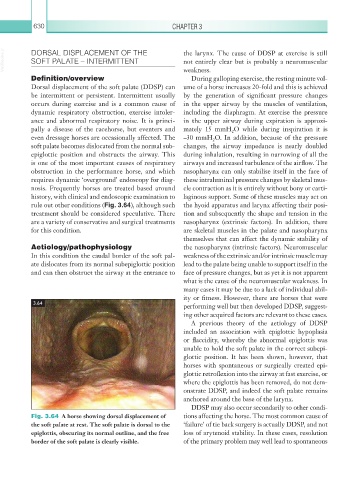Page 655 - Equine Clinical Medicine, Surgery and Reproduction, 2nd Edition
P. 655
630 CHAPTER 3
VetBooks.ir DORSAL DISPLACEMENT OF THE the larynx. The cause of DDSP at exercise is still
SOFT PALATE – INTERMITTENT
not entirely clear but is probably a neuromuscular
Definition/overview weakness.
During galloping exercise, the resting minute vol-
Dorsal displacement of the soft palate (DDSP) can ume of a horse increases 20-fold and this is achieved
be intermittent or persistent. Intermittent usually by the generation of significant pressure changes
occurs during exercise and is a common cause of in the upper airway by the muscles of ventilation,
dynamic respiratory obstruction, exercise intoler- including the diaphragm. At exercise the pressure
ance and abnormal respiratory noise. It is princi- in the upper airway during expiration is approxi-
pally a disease of the racehorse, but eventers and mately 15 mmH O while during inspiration it is
2
even dressage horses are occasionally affected. The –30 mmH O. In addition, because of the pressure
2
soft palate becomes dislocated from the normal sub- changes, the airway impedance is nearly doubled
epiglottic position and obstructs the airway. This during inhalation, resulting in narrowing of all the
is one of the most important causes of respiratory airways and increased turbulence of the airflow. The
obstruction in the performance horse, and which nasopharynx can only stabilise itself in the face of
requires dynamic ‘overground’ endoscopy for diag- these intraluminal pressure changes by skeletal mus-
nosis. Frequently horses are treated based around cle contraction as it is entirely without bony or carti-
history, with clinical and endoscopic examination to laginous support. Some of these muscles may act on
rule out other conditions (Fig. 3.64), although such the hyoid apparatus and larynx affecting their posi-
treatment should be considered speculative. There tion and subsequently the shape and tension in the
are a variety of conservative and surgical treatments nasopharynx (extrinsic factors). In addition, there
for this condition. are skeletal muscles in the palate and nasopharynx
themselves that can affect the dynamic stability of
Aetiology/pathophysiology the nasopharynx (intrinsic factors). Neuromuscular
In this condition the caudal border of the soft pal- weakness of the extrinsic and/or intrinsic muscle may
ate dislocates from its normal subepiglottic position lead to the palate being unable to support itself in the
and can then obstruct the airway at the entrance to face of pressure changes, but as yet it is not apparent
what is the cause of the neuromuscular weakness. In
many cases it may be due to a lack of individual abil-
ity or fitness. However, there are horses that were
3.64 performing well but then developed DDSP, suggest-
ing other acquired factors are relevant to these cases.
A previous theory of the aetiology of DDSP
included an association with epiglottic hypoplasia
or flaccidity, whereby the abnormal epiglottis was
unable to hold the soft palate in the correct subepi-
glottic position. It has been shown, however, that
horses with spontaneous or surgically created epi-
glottic retroflexion into the airway at fast exercise, or
where the epiglottis has been removed, do not dem-
onstrate DDSP, and indeed the soft palate remains
anchored around the base of the larynx.
DDSP may also occur secondarily to other condi-
Fig. 3.64 A horse showing dorsal displacement of tions affecting the horse. The most common cause of
the soft palate at rest. The soft palate is dorsal to the ‘failure’ of tie back surgery is actually DDSP, and not
epiglottis, obscuring its normal outline, and the free loss of arytenoid stability. In these cases, resolution
border of the soft palate is clearly visible. of the primary problem may well lead to spontaneous

